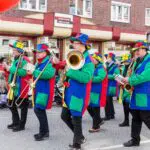Guam History and Chamorro Heritage Day is on the first Monday in March every year and this year, it falls on March 3. Most of us may be aware that Guam is a former Spanish colony. Others may recognize it as the home of several U.S. military bases. But what many don’t know is the story of the island itself — the incredible people, culture, and heritage. Guam is the largest island in Micronesia and home to the indigenous Chamorro people. Over centuries of colonialism and turmoil, the songs, language, and soul of the Chamorro lie forgotten, but Guam History and Chamorro Heritage Day reclaims some of these lost narratives. It is a day of traditional song, dance, food, and storytelling and isn’t just a celebration of the Chamorro identity but provides a vision for their future.
History of Guam History And Chamorro Heritage Day
Guam History and Chamorro Heritage Day was once a commemoration of the anniversary of the island’s discovery by the Portuguese explorer Ferdinand Magellan. Over the years, the spirit and tenor of the day have evolved. Magellan’s discovery of Guam signaled the beginning of the end for the island’s indigenous Chamorro people. For every Guamanian, it’s a painful reminder of 400 years of colonization as Spain, the U.S., and Japan battled each other for administrative control. Eventually, the islanders paid the highest price. The Chamorro all but lost their culture and identity. After World War II, Guam became an unincorporated territory of the U.S. and is a strategic U.S. naval base in the Pacific today.
The enormous loss of culture and heritage continues to impact Guamanian politics and culture profoundly. The holiday hopes to change the narratives and fill all the gaps. Guam History and Chamorro Heritage Day is a national public holiday on the island when Guamanians celebrate their indigenous heritage, culture, and right to self-determination. The island-wide celebrations embody the core Chamorro values of respect, community, reciprocity, and love.
That’s not all. The day kicks off the festivities as part of ‘Mes Chamoru,’ a month of exciting cultural events. One of the most anticipated events is a re-enactment of Magellan’s arrival in Guam. The re-enactment seeks to remind, not celebrate, Guamanians of his landing, which is a story they must tell for future generations. Through remembering the past, the Guamanians address a history of enormous cultural loss and pave a new path for their future.
Guam History And Chamorro Heritage Day timeline
The earliest Chamorro people arrive in Guam and plant the roots of a rich culture.
Guam comes under U.S. Navy rule after the end of the Spanish-American War.
Soon after bombing Pearl Harbour, Japanese forces invade and capture Guam.
Guamanians, or people who call Guam home, become U.S. citizens with limited self-government.
Guam History And Chamorro Heritage Day FAQs
What does ‘Mes Chamoru’ mean?
‘Mes Chamoru’ is Guamanian for ‘Guam History and Chamorro Heritage Month.’ ‘Mes’ is Spanish for ‘month.’
What month is Chamorro?
Come March each year, and it’s the celebration of Chamorro Month. Guamanians celebrate the month through traditional dancing, weaving, food, and fashion.
What are Chamorros mixed with?
The Chamorros are primarily of Austronesian descent. Guam’s population is 40% indigenous Chamorro, 25% Filipino, and the rest are Asians, Pacific Islanders, and Caucasians.
How to Observe Guam History And Chamorro Heritage Day
Eat like a Guamanian
Filipino migrant workers introduced Guam to different versions of spring roll or ‘lumpia.’ A Chamorro fiesta table isn’t complete without crunchy lumpia that come with a filling of meat and veggies.
Learn Chamorro
What is the best way to pay tribute to a culture? Learn the language. When in Guam, even a ‘Håfa Adai’ (‘Hello’ in Chamorro) will go a long way and help you make new friends.
Catch a traditional Chamorro dance performance
Visit the Wednesday night market at the Chamorro Village to watch a traditional Chamorro dance performance. Or time your visit to coincide with one of the beautiful village festivals that take place annually.
5 Facts About Micronesia That Will Blow Your Mind
All four one
The four culturally distinct islands of Yap, Pohnpei, Chuuk, and Kosrae make up the Federated States of Micronesia.
Less than 45,000 visitors each year
Micronesia has very little tourist footfall because it’s so tiny and remote.
A dot in the ocean
The tiny island of Pohnpei has one main road, and everyone knows where everyone else lives.
Don’t visit empty-handed
Visitors to Yap must carry a green leaf to signify peaceful intentions.
A diver’s paradise
Divers visit Chuuk to explore the wrecks of over 50 ships that sank in these waters during World War II.
Why Guam History And Chamorro Heritage Day is Important
It keeps culture alive
Guam History And Chamorro Heritage Day is integral to reviving and keeping indigenous cultures alive. Only through collective action can we save ancient cultures and their infinite wisdom.
Some perspective in retrospect
History tends to favor singular narratives unless you choose to go deeper. Learning about Guam offers multiple perspectives on history.
It celebrates diversity
A world of diversity makes us better, more empathetic people. Guam History and Chamorro Heritage Day is a crucial reminder of this fact.
Guam History And Chamorro Heritage Day dates
| Year | Date | Day |
|---|---|---|
| 2022 | March 7 | Monday |
| 2023 | March 6 | Monday |
| 2024 | March 4 | Monday |
| 2025 | March 3 | Monday |
| 2026 | March 2 | Monday |
























































